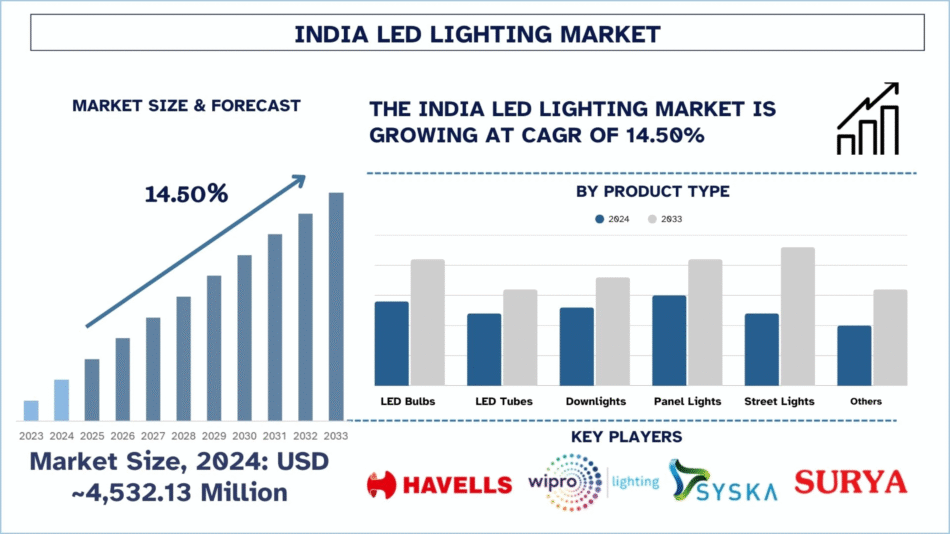According to the UnivDatos, rising disposable incomes, government programs like UJALA and SLNP promoting LED adoption, rising consumer awareness of energy savings, lower LED prices, and increasing infrastructure development in Tier II and Tier III cities drive the India LED Lighting market. As per their “India LED Lighting Market” report, the Indian market was valued at USD ~4,532.13 million in 2024, growing at a CAGR of about 14.50% during the forecast period from 2025 – 2033 to reach USD million by 2033.
Smart city projects, efforts from the government, and a desire for energy savings are pushing India’s LED industry into a major transformation. Now, LED lights are common in homes, regardless of where people live. In addition to cost-effectiveness and low prices, the industry is busy with sweeping revisions to regulations, new technology, and more attention to environmental issues. This article studies the recent progress and policies guiding the future of the LED lighting sector in India in 2025.
Access sample report (including graphs, charts, and figures): https://univdatos.com/reports/india-led-lighting-market?popup=report-enquiry
The Energy Efficiency Mission Is Making Positive Progress
The Street Lighting National Program (SLNP) and UJALA have remained the biggest demand generators for LED lights in India. Such initiatives are designed to let people know that they should choose LED lights over incandescent, CFL, and halogen bulbs.
The Energy Efficiency Services Limited (EESL) is adding more cities to its Street Lighting National Programme (SLNP) by adding IoT-based dimming, motion sensors, and adaptive lighting to LED streetlights. Because such lights consume less energy when demand is low, utility and expenses for local governments are kept down.
UJALA’s Decade of Impact:
As of 6th January 2025, the UJALA scheme has distributed 36.87 crore LED bulbs, making it one of the most widely adopted initiatives in the country. Its implementation across all states has brought about transformative changes, reduced annual household electricity bills, and enabled consumers to save money while improving their quality of life. By ensuring transparency through e-procurement and fostering competition, the programme has significantly reduced transaction costs and time, leading to enhanced process efficiency. Also, transforming the market, so far, the UJALA scheme has generated the sale of 407.92 crore LED bulbs in the Indian market.
Street Lighting National Programme (SLNP):
As of 6th January 2025, EESL installed over 1.34 crore LED streetlights across Urban Local Bodies (ULBs) and Gram Panchayats, leading to significant energy savings of over 9,001 million units (MUs) of electricity annually. This achievement also contributed to a reduction in peak demand by more than 1,500 MW and a decrease in CO₂ emissions by 6.2 million tonnes per year, highlighting the programme’s positive impact on both energy efficiency and environmental sustainability.
Integrating Smart Cities with LEDs
LED technology has seen its widest usage for testing in India’s smart cities. Adding to this, using integrated LED systems, cities such as Pune, Bhopal, and Surat are now able to manage the lighting for streets, buildings, and traffic intersections from one location. Moreover, the rising use of AI and IoT in these systems to detect flaws, observe energy use, and set the illumination based on real-time traffic.
So far, 1.5 million LED streetlights have been installed in 100 cities through the Smart Cities Mission, and future projects will put LEDs in parks, around footpaths, and in transit areas. More and more, LED lighting is working with surveillance cameras, emergency networks, and tools for pollution monitoring.
Click here to view the Report Description & TOC: https://univdatos.com/reports/india-led-lighting-market
New Technologies in Lighting: Li-Fi and Human-Centric Lighting
LED technology is moving forward with improved features, not just improved efficiency. Li-Fi and HCL are two major trends appearing in India’s advanced lighting sector.
Under MeitY’s collaboration, Li-Fi, which transmits information with light through LEDs, is currently being pilot tested. With this technology, secure and speedy transfer of data could be just as good as or better than current Wi-Fi, mainly in the military and healthcare sectors.
For instance, the Centre for Development of Advanced Computing (C-DAC), Chennai, under the Ministry of Electronics and Information Technology (MeitY), signed a Transfer of Technology (ToT) agreement for its cutting-edge technologies, NLOS VICINITY and ILLUMINATE, with Nav Wireless Technologies Pvt. Ltd on November 28, 2024. The agreement was formalized at Electronics Niketan, New Delhi, by Dr. D. Ethirajan, Scientist F and Centre Head, C-DAC Chennai, and Sh. Hardik Raval, Head of the Embedded Department at Nav Wireless Technologies Pvt. Ltd.
India’s LED Revolution Shines Bright
India’s LED lighting industry is growing rapidly because of improved laws, new technologies, and a focus on sustainability. The rise of quality and efficiency is thanks to government programs, including BIS standards, e-waste compliance, and the adoption of smart city solutions. The Make in India initiative is encouraging India to be self-reliant and send its exports worldwide. As the industry keeps improving and regulators promote progress, it will help create a greener and smarter future.
Contact Us:
UnivDatos
Contact Number – +1 978 733 0253
Email – contact@univdatos.com
Website – www.univdatos.com
Linkedin- https://www.linkedin.com/company/univ-datos-market-insight/mycompany/







